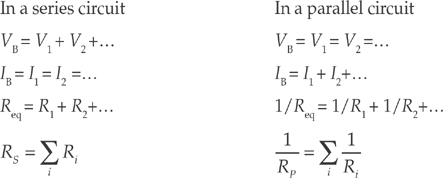
In Chapter 10, when we studied electrostatic fields, we learned that, within a conductor, an electrostatic field cannot be sustained; the source charges move to the surface and the conductor forms a single equipotential. We will now look at conductors within which an electric field can be sustained because a power source maintains a potential difference across the conductor, allowing charges to continually move through it. This ordered motion of charge through a conductor is called electric current.
Picture a piece of metal wire. Within the metal, electrons are zooming around at speeds of about a million m/s in random directions, colliding with other electrons and positive ions in the lattice. This constitutes charge in motion, but it doesn’t constitute net movement of charge, because the electrons move randomly. If there’s no net motion of charge, there’s no current. However, if we were to create a potential difference between the ends of the wire, meaning if we set up an electric field, the electrons would experience an electric force, and they would start to drift through the wire. This is current. Although the electric field would travel through the wire at nearly the speed of light, the electrons themselves would still have to make their way through a crowd of atoms and other free electrons, so their drift speed, vd, would be relatively slow, on the order of a millimeter per second.

To measure the current, we have to measure how much charge crosses a plane per unit time. If an amount of charge of magnitude ∆Q crosses an imaginary plane in a time interval ∆t, then the average current is
Because current is charge per unit time, it’s expressed in coulombs per second. One coulomb per second is an ampere (abbreviated A), or amp. So 1 C/s = 1 A.
Although the charge carriers that constitute the current within a metal are electrons, the direction of the current is taken to be the direction that positive charge carriers would move. (This is explicitly stated on the AP Physics Exam.) So, if the conduction electrons drift to the right, we’d say the current points toward the left.
Let’s say we had a copper wire and a glass fiber that had the same length and cross-sectional area, and that we hooked up the ends of the metal wire to a source of potential difference and measured the resulting current. If we were to do the same thing with the glass fiber, the current would probably be too small to measure, but why? Well, the glass provided more resistance to the flow of charge. If the potential difference is V and the current is I, then the resistance is
This is known as Ohm’s Law. Not all devices are ohmic, but many are. Notice for the same voltage if the current is large, the resistance is low, and if the current is small, then resistance is high. The ∆ in the equation above is often omitted, but you should always assume that, in this context V = ∆V = potential difference, also called voltage.
Because resistance is voltage divided by current, it is expressed in volts per amp. One volt per amp is one ohm (Ω, omega). So, 1 V/A = 1 Ω.
The resistance of an object depends on two things: the material it’s made of and its shape. For example, again think of the copper wire and glass fiber of the same length and area. They have the same shape, but their resistances are different because they’re made of different materials. Glass has a much greater intrinsic resistance than copper does; it has a greater resistivity. Each material has its own characteristic resistivity, and resistance depends on how the material is shaped. For a wire of length L and cross-sectional area A made of a material with resistivity ρ, resistance is given by:
The resistivity of copper is around 10–8 Ω·m, while the resistivity of glass is much greater, around 1012 Ω·m.
Example 12.1 A wire of radius 1 mm and length 2 m is made of platinum (resistivity = 1 × 10–7 Ω·m). If a voltage of 9 V is applied between the ends of the wire, what will be the resulting current?
Solution. First, the resistance of the wire is given by the equation
Then, from I = V/R, we get
An electric current is maintained when the terminals of a voltage source (a battery, for example) are connected by a conducting pathway, in what’s called a circuit. If the current always travels in the same direction through the pathway, it’s called a direct current.
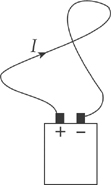
The job of the voltage source is to provide a potential difference called an emf, or electromotive force, which drives the flow of charge. The emf isn’t really a force, it’s the work done per unit charge, and it’s measured in volts.
To try to imagine what’s happening in a circuit in which a steady-state current is maintained, let’s follow one of the charge carriers that’s drifting through the pathway. (Remember we’re pretending that the charge carriers are positive.) The charge is introduced by the positive terminal of the battery and enters the wire, where it’s pushed by the electric field. It encounters resistance, bumping into the relatively stationary atoms that make up the metal’s lattice and setting them into greater motion. So the electrical potential energy that the charge had when it left the battery is turning into heat. By the time the charge reaches the negative terminal, all of its original electrical potential energy is lost. In order to keep the current going, the voltage source must do positive work on the charge, forcing it to move from the negative terminal toward the positive terminal. The charge is now ready to make another journey around the circuit.
When a carrier of positive charge q drops by an amount V in potential, it loses potential energy in the amount qV. If this happens in time t, then the rate at which this energy is transformed is equal to (qV)/t = (q/t)V. But q/t is equal to the current, I, so the rate at which electrical energy is transferred is given by the equation
This equation works for the power delivered by a battery to the circuit as well as for resistors. The power dissipated in a resistor, as electrical potential energy is turned into heat, is given by P = IV, but, because of the relationship V = IR, we can express this in two other ways:
or
Resistors become hot when current passes through them.
We will now develop a way of specifying the current, voltage, and power associated with each element in a circuit. Our circuits will contain three basic elements: batteries, resistors, and connecting wires. As we’ve seen, the resistance of an ordinary metal wire is negligible; resistance is provided by devices that control the current: resistors. All the resistance of the system is concentrated in the resistors, which are symbolized in a circuit diagram by this symbol:
Batteries are denoted by the symbol:

where the longer line represents the positive (higher potential) terminal, and the shorter line is the negative (lower potential) terminal. Sometimes a battery is denoted by more than one pair of such lines:

Here’s a simple circuit diagram:

The electric potential (V) of the battery is indicated, as is the resistance (R) of the resistor. Determining the current in this case is straightforward, because there’s only one resistor. The equation V = IR gives us
Two common ways of combining resistors within a circuit is to place them either in series (one after the other),

or in parallel (that is, side-by-side):
In order to simplify the circuit, our goal is to find the equivalent resistance of combinations. Resistors are said to be in series if they all share the same current and if the total voltage drop across them is equal to the sum of the individual voltage drops.

In this case, then, if V denotes the voltage drop across the combination, we have
This idea can be applied to any number of resistors in series (not just two):
Resistors are said to be in parallel if they all share the same voltage drop, and the total current entering the combination is split among the resistors. Imagine that a current I enters the combination. It splits; some of the current, I1, would go through R1, and the remainder, I2, would go through R2.

So if V is the voltage drop across the combination, we have
This idea can be applied to any number of resistors in parallel (not just two): The reciprocal of the equivalent resistance for resistors in parallel is equal to the sum of the reciprocals of the individual resistances:
Example 12.2 Calculate the equivalent resistance for the following circuit:
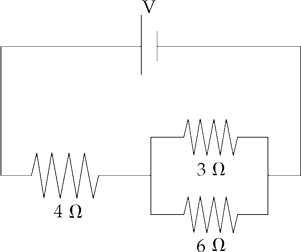
Solution. First find the equivalent resistance of the two parallel resistors:
This resistance is in series with the 4 Ω resistor, so the overall equivalent resistance in the circuit is R = 4 Ω + 2 Ω = 6 Ω.
Example 12.3 Determine the current through each resistor, the voltage drop across each resistor, and the power given off (dissipated) as heat in each resistor of this circuit:
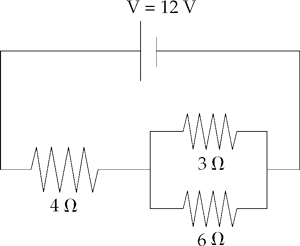
Solution. You might want to redraw the circuit each time we replace a combination of resistors by its equivalent resistance. From our work in the preceding example, we have

From diagram ![]() , which has just one resistor, we can figure out the current:
, which has just one resistor, we can figure out the current:
Now we can work our way back to the original circuit (diagram ![]() ). In going from
). In going from ![]() to
to ![]() , we are going back to a series combination, and what do resistors in series share? That’s right, the same current. So, we take the current, I = 2 A, back to diagram
, we are going back to a series combination, and what do resistors in series share? That’s right, the same current. So, we take the current, I = 2 A, back to diagram ![]() . The current through each resistor in diagram
. The current through each resistor in diagram ![]() is 2 A.
is 2 A.
Since we know the current through each resistor, we can figure out the voltage drop across each resistor using the equation V = IR. The voltage drop across the 4 Ω resistor is (2 A)(4 Ω) = 8 V, and the voltage drop across the 2 Ω resistor is (2 A)(2 Ω) = 4 V. Notice that the total voltage drop across the two resistors is 8 V + 4 V = 12 V, which matches the emf of the battery.
Now for the last step; going from diagram ![]() back to diagram
back to diagram ![]() . Nothing needs to be done with the 4 Ω resistor; nothing about it changes in going from diagram
. Nothing needs to be done with the 4 Ω resistor; nothing about it changes in going from diagram ![]() to
to ![]() , but the 2 Ω resistor in diagram
, but the 2 Ω resistor in diagram ![]() goes back to the parallel combination. And what do resistors in parallel share? The same voltage drop. So we take the voltage drop, V = 4 V, back to diagram
goes back to the parallel combination. And what do resistors in parallel share? The same voltage drop. So we take the voltage drop, V = 4 V, back to diagram ![]() . The voltage drop across each of the two parallel resistors in diagram
. The voltage drop across each of the two parallel resistors in diagram ![]() is 4 V.
is 4 V.
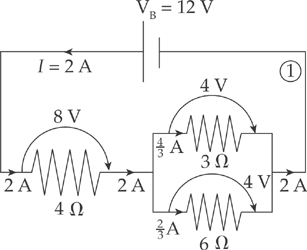
Since we know the voltage drop across each resistor, we can figure out the current through each resistor by using the equation I = V/R. The current through the 3 Ω resistor is (4 V)/(3 Ω) = ![]() A, and the current through the 6 Ω resistor is (4 V)/(6 Ω) =
A, and the current through the 6 Ω resistor is (4 V)/(6 Ω) = ![]() A. Note that the current entering the parallel combination (2 A) equals the total current passing through the individual resistors
A. Note that the current entering the parallel combination (2 A) equals the total current passing through the individual resistors ![]() . Again this was expected.
. Again this was expected.
Finally, we will calculate the power dissipated as heat by each resistor. We can use any of the equivalent formulas: P = IV, P = I 2R, or P = V 2/R.

So, the resistors are dissipating a total of
If the resistors are dissipating a total of 24 J every second, then they must be provided with that much power. This is easy to check: P = IV = (2 A)(12 V) = 24 W.
Example 12.4 For the following circuit,
(a) In which direction will current flow and why?
(b) What’s the overall emf?
(c) What’s the current in the circuit?
(d) At what rate is energy consumed by, and provided to, this circuit?

Solution.
(a) The battery V1 wants to send current clockwise, while the battery V2 wants to send current counterclockwise. Since V2 > V1, the battery whose emf is V2 is the more powerful battery, so the current will flow counterclockwise.
(b) Charges forced through V1 will lose, rather than gain, 4 V of potential, so the overall emf of this circuit is V2 – V1 = 8 V.
(c) Since the total resistance is 3 Ω + 1 Ω = 4 Ω, the current will be I = (8 V)/(4 Ω) = 2 A.
(d) V2 will provide energy at a rate of P2 = IV2 = (2 A)(12 V) = 24 W, while V1 will absorb at a rate of P1 = IV1 = (2 A)(4 V) = 8 W. Finally, energy will be dissipated in these resistors at a rate of I2R1 + I2R2 = (2 A)2(3 Ω) + (2 A)2(1 Ω) = 16 W. Once again, energy is conserved; the power delivered (24 W) equals the power taken (8 W + 16 W = 24 W).
Example 12.5 All real batteries contain internal resistance, r. Determine the current in the following circuit when the switch S is closed:
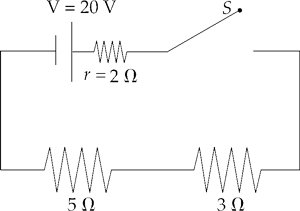
Solution. Before the switch is closed, there is no complete conducting pathway from the positive terminal of the battery to the negative terminal, so no current flows through the resistors. However, once the switch is closed, the resistance of the circuit is 2 Ω + 3 Ω + 5 Ω = 10 Ω, so the current in the circuit is I = (20 V)/(10 Ω) = 2 A. Often the battery and its internal resistance are enclosed in a dashed box:
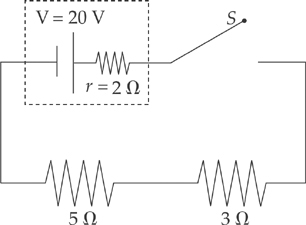
In this case, a distinction can be made between the emf of the battery and the actual voltage it provides once the current has begun. Since I = 2 A, the voltage drop across the internal resistance is Ir = (2 A)(2 Ω) = 4 V, so the effective voltage provided by the battery to the rest of the circuit—called the terminal voltage—is lower than the ideal voltage. It is V = VB – Ir = 20 V – 4 V = 16 V.
Example 12.6 A student has three 30 Ω resistors and an ideal 90 V battery. (A battery is ideal if it has a negligible internal resistance.) Compare the current drawn from—and the power supplied by—the battery when the resistors are arranged in parallel versus in series.
Solution. Resistors in series always provide an equivalent resistance that’s greater than any of the individual resistances, and resistors in parallel always provide an equivalent resistance that’s smaller than their individual resistances. So, hooking up the resistors in parallel will create the smallest resistance and draw the greatest total current:

In this case, the equivalent resistance is
and the total current is I = V/RP = (90 V)/(10 Ω) = 9 A. (You could verify that 3 A of current would flow in each of the three branches of the combination.) The power supplied by the battery will be P = IV = (9 A)(90 V) = 810 W.
If the resistors are in series, the equivalent resistance is RS = 30 Ω + 30 Ω + 30 Ω = 90 Ω, and the current drawn is only I = V/RS = (90 V)/(90 Ω) = 1 A. The power supplied by the battery in this case is just P = IV = (1 A)(90 V) = 90 W.
Example 12.7 A voltmeter is a device that’s used to measure the voltage between two points in a circuit. An ammeter is used to measure current. Determine the readings on the voltmeter (denoted ![]() ) and the ammeter (denoted
) and the ammeter (denoted ![]() ) in the circuit below.
) in the circuit below.
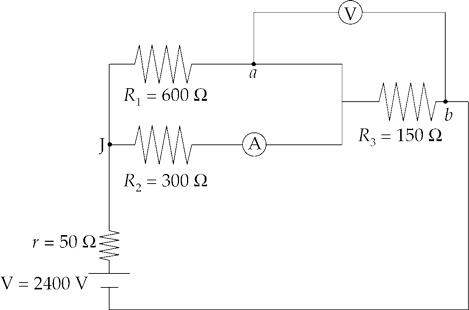
Solution. We consider the ammeter to be ideal; this means it has negligible resistance, so it doesn’t alter the current that it’s trying to measure. Similarly, we consider the voltmeter to have an extremely high resistance, so it draws negligible current away from the circuit.
Our first goal is to find the equivalent resistance in the circuit. The 600 Ω and 300 Ω resistors are in parallel; they’re equivalent to a single 200 Ω resistor. This is in series with the battery’s internal resistance, r, and R3. The overall equivalent resistance is therefore R = 50 Ω + 200 Ω + 150 Ω = 400 Ω, so the current supplied by the battery is I = V/R (2400 V)/(400 Ω) = 6 A. At the junction marked J, this current splits. Since R1 is twice R2, half as much current will flow through R1 as through R2; the current through R1 is I1 = 2 A, and the current through R2 is I2 = 4 A. The voltage drop across each of these resistors is I1R1 = I2R2 = 1200 V (matching voltages verify the values of currents I1 and I2). Since the ammeter is in the branch that contains R2, it will read I2 = 4 A.
The voltmeter will read the voltage drop across R3, which is V3 = IR3 = (6 A)(150 Ω) = 900 V. So the potential at point b is 900 V lower than at point a.
Example 12.8 The diagram below shows a point a at potential V = 20 V connected by a combination of resistors to a point (denoted G) that is grounded. The ground is considered to be at potential zero. If the potential at point a is maintained at 20 V, what is the current through R3?
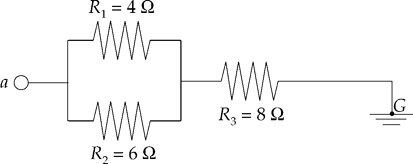
Solution. R1 and R2 are in parallel; their equivalent resistance is RP, where
RP is in series with R3, so the equivalent resistance is:
and the current that flows through R3 is
When the resistors in a circuit cannot be classified as either in series or in parallel, we need another method for analyzing the circuit. The rules of Gustav Kirchhoff (pronounced “Keer koff”) can be applied to any circuit:
The Loop Rule just says that, starting at any point, by the time we get back to that same point by following any closed loop, we have to be back to the same potential. Therefore, the total drop in potential must equal the total rise in potential. Put another way, the Loop Rule says that all the decreases in electrical potential energy (for example, caused by resistors in the direction of the current) must be balanced by all the increases in electrical potential energy (for example, caused by a source of emf from the negative to positive terminal). So the Loop Rule is basically a re-statement of the Law of Conservation of Energy.
Similarly, the Junction Rule simply says that the charge (per unit time) that goes into a junction must equal the charge (per unit time) that comes out. This is basically a statement of the Law of Conservation of Charge.
In practice, the Junction Rule is straightforward to apply. The most important things to remember about the Loop Rule can be summarized as follows:
Example 12.9 Use Kirchhoff’s Rules to determine the current through R2 in the following circuit:

Solution. First let’s label some points in the circuit.

The points c and f are junctions (nodes). We have two nodes and three branches: one branch is fabc, another branch is cdef, and the third branch is cf. Each branch has one current throughout. If we label the current in fabc I1 and the current in branch cdef I2 (with the directions as shown in the diagram below), then the current in branch cf must be I1 – I2, by the Junction Rule: I1 comes into c, and a total of I2 + (I1 – I2) = I1 comes out.
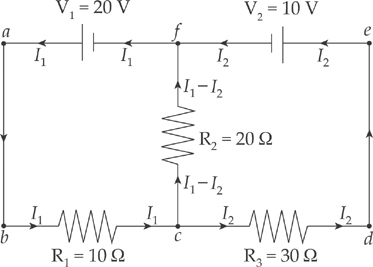
Now pick a loop; say, abcfa. Starting at a, we go to b, then across R1 in the direction of the current, so the potential drops by I1R1. Then we move to c, then up through R2 in the direction of the current, so the potential drops by (I1 – I2)R2. Then we reach f, turn left and travel through V1 from the negative to the positive terminal, so the potential increases by V1. We now find ourselves back at a. By the Loop Rule, the total change in potential around this closed loop must be zero, and
Since we have two unknowns (I1 and I2), we need two equations, so now pick another loop; let’s choose cdefc. From c to d, we travel across the resistor in the direction of the current, so the potential drops by I2R3. From e to f, we travel through V2 from the positive to the negative terminal, so the potential drops by V2. Heading down from f to c, we travel across R2 but in the direction opposite to the current, so the potential increases by (I1 – I2)R2. At c, our loop is completed, so
Substituting in the given numerical values for R1, R2, R3, V1, and V2, and simplifying, these two equations become
Solving this pair of simultaneous equations, we get
So the current through R2 is I1 – I2 = ![]() A = 0.64 A.
A = 0.64 A.
The choice of directions of the currents at the beginning of the solution was arbitrary. Don’t worry about trying to guess the actual direction of the current in a particular branch. Just pick a direction, stick with it, and obey the Junction Rule. At the end, when you solve for the values of the branch current, a negative value will alert you that the direction of the current is actually opposite to the direction you originally chose for it in your diagram.
Capacitors are typically charged by batteries. Once the switch in the diagram on the left is closed, electrons are attracted to the positive terminal of the battery and leave the top plate of the capacitor. Electrons also accumulate on the bottom plate of the capacitor, and this continues until the voltage across the capacitor plates matches the emf of the battery. When this condition is reached, the current stops and the capacitor is fully charged.

Example 12.10 Determine the current through and the voltage across each electrical device in the following circuit when
(a) the switch has just been closed
(b) the switch has been thrown for a long period of time
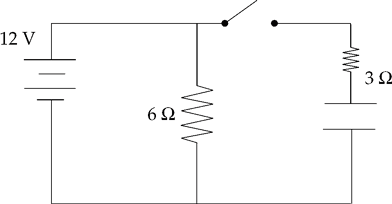
Solution.
(a) When the switch has just been closed, the capacitor is treated like a wire with no resistance. The circuit behaves like a simple parallel circuit. There are 12 V across the 6 Ω resistor so 2 amps of current flow through it. There are 12 V across the 3 Ω resistor so 4 amps flow through it. By Kirchhoff’s Law, the currents add to 6 amps through the battery and the equivalent resistance of the circuit is 2 Ω.
(b) After the switch has been closed for a long period of time, the capacitor behaves like an infinite resistor. There are still 12 V across the 6 Ω resistor so 2 amps of current still flow through it. If the capacitor behaves like an infinite resistor, no current can flow through that branch. There will be no current through the 3 Ω resistor. The capacitor will have 12 V across it and there will be no voltage across the 3 Ω resistor (otherwise current would be flowing through it). The current will be 2 amps through the battery and the equivalent resistance of the circuit is 6 Ω.
Example 12.11 Determine the current through and the voltage across each electrical device in the following circuit when
(a) the switch has just been closed
(b) the switch has been thrown for a long period of time
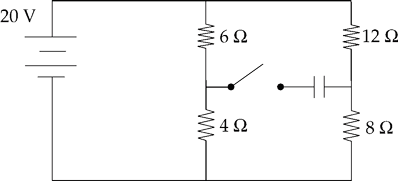
Solution.
(a) Immediately after one throws the switch, the capacitor exhibits behavior similar to that of a wire with no resistance through it. The circuit can be redrawn and thought of as
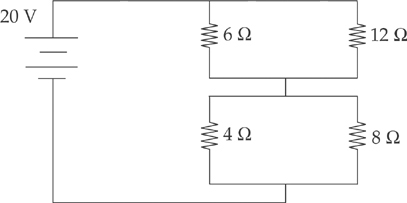
The 6 Ω and 12 Ω resistors are in parallel and can be thought of as 4 Ω (from 1/Req = 1/R1 + 1/R2). Similarly, the 4 Ω and 8 Ω resistors are in parallel and can be thought of as 2.67 Ω (again, from 1/Req = 1/R1 + 1/R2). The equivalent resistance of these two branches, which are in series with each other, is 6.67 Ω (from Req = R1 + R2).
The current through the battery is therefore 3 amps (from Ohm’s Law, V = IR).
The current through the 6 Ω and 12 Ω (top two resistors) is 3 amps traveling through an effective resistance of 4 Ω. The voltage drop across the top branch is 12 V (from Ohm’s Law). The currents through the 6 Ω and 12 Ω resistors are 2 amps and 1 amp, respectively (again from Ohm’s Law).
The current through the 4 Ω and 8 Ω (bottom two resistors) is also 3 amps through an effective resistance of 2.67 Ω. The voltage drop across the branch is 8 V (from Ohm’s Law or from the fact that the voltage across each series section must sum to the total voltage across the battery). The currents through the 4 Ω and 8 Ω resistors are 2 amps and 1 amp, respectively (again from Ohm’s Law).
(b) When the switch has been closed for a long period of time, the capacitor behaves just like an infinite resistor. The circuit can be redrawn and thought of as

The 6 Ω and 4 Ω resistors are in series and can be thought of as a 10 Ω resistor (from Req = R1 + R2). Similarly, the 12 Ω and 8 Ω resistors can be thought of as 20 Ω (again, from Req = R1 + R2). Since the branches are in parallel, the voltage is 20 volts across each path and the current can be calculated by Ohm’s Law (V = IR); 2 amps go through the left branch (the 6 Ω and 4 Ω resistor) and 1 amp goes through the right branch (the 12 Ω and 8 Ω resistor).
The current through the battery is therefore 3 amps (Kirchhoff’s Node Rule).
The voltage across each of the 6 Ω, 4 Ω, 12 Ω, and 8 Ω resistors can be obtained from Ohm’s Law. They are 12 V, 8 V, 12 V, and 8 V, respectively.
Solutions can be found in Chapter 18.
1. A wire made of brass and a wire made of silver have the same length, but the diameter of the brass wire is 4 times the diameter of the silver wire. The resistivity of brass is 5 times greater than the resistivity of silver. If RB denotes the resistance of the brass wire and RS denotes the resistance of the silver wire, which of the following is true?
(A) RB = ![]() RS
RS
(B) RB = ![]() RS
RS
(C) RB = ![]() RS
RS
(D) RB = ![]() RS
RS
(E) RB = ![]() RS
RS
2. For an ohmic conductor, doubling the voltage without changing the resistance will cause the current to
(A) decrease by a factor of 4
(B) decrease by a factor of 2
(C) remain unchanged
(D) increase by a factor of 2
(E) increase by a factor of 4
3. If a 60-watt light bulb operates at a voltage of 120 V, what is the resistance of the bulb?
(A) 2 Ω
(B) 30 Ω
(C) 240 Ω
(D) 720 Ω
(E) 7200 Ω
4. A battery whose emf is 40 V has an internal resistance of 5 Ω. If this battery is connected to a 15 Ω resistor R, what will the voltage drop across R be?
(A) 10 V
(B) 30 V
(C) 40 V
(D) 50 V
(E) 70 V
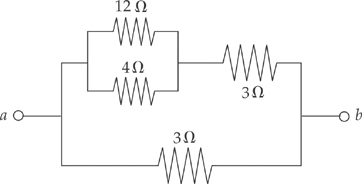
Determine the equivalent resistance between points a and b.
(A) 0.167 Ω
(B) 0.25 Ω
(C) 0.333 Ω
(D) 1.5 Ω
(E) 2 Ω

Three identical light bulbs are connected to a source of emf, as shown in the diagram above. What will happen if the middle bulb burns out?
(A) All the bulbs will go out.
(B) The light intensity of the other two bulbs will decrease (but they won’t go out).
(C) The light intensity of the other two bulbs will increase.
(D) The light intensity of the other two bulbs will remain the same.
(E) More current will be drawn from the source of emf.
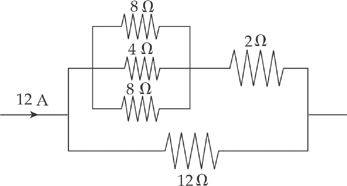
What is the voltage drop across the 12 Ω resistor in the portion of the circuit shown above?
(A) 24 V
(B) 36 V
(C) 48 V
(D) 72 V
(E) 144 V

What is the current through the 8 Ω resistor in the circuit shown above?
(A) 0.5 A
(B) 1.0 A
(C) 1.25 A
(D) 1.5 A
(E) 3.0 A
9. How much energy is dissipated as heat in 20 s by a 100 Ω resistor that carries a current of 0.5 A?
(A) 50 J
(B) 100 J
(C) 250 J
(D) 500 J
(E) 1000 J
1. Consider the following circuit:
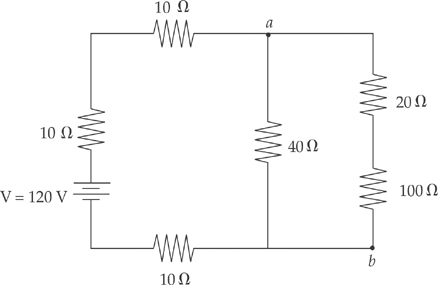
(a) At what rate does the battery deliver energy to the circuit?
(b) Find the current through the 40 Ω resistor.
(c) (i) Determine the potential difference between points a and b.
(ii) At which of these two points is the potential higher?
(d) Find the energy dissipated by the 100 Ω resistor in 10 s.
(e) Given that the 100 Ω resistor is a solid cylinder that’s 4 cm long, composed of a material whose resistivity is 0.45 Ω·m, determine its radius.
2. Consider the following circuit:
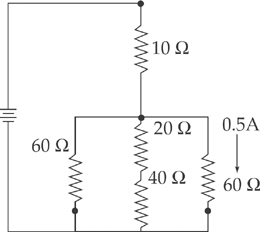
(a) What is the current through each resistor?
(b) What is the potential difference across each resistor?
(c) What is the equivalent resistance of the circuit?
This is the same power we’ve encountered in our discussion of energy P = ![]() .
.
